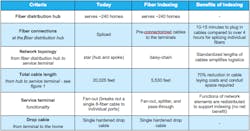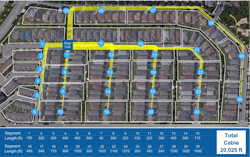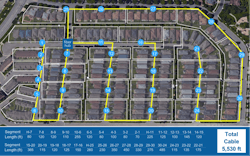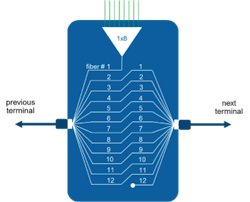Deploying FTTH? Discover a Faster Way to Bring Fiber to the Home or Business
The Economics of Fiber
ver a decade has passed since the first FTTH network deployments, yet the cost of building a network remains the primary obstacle to ubiquitous fiber connectivity for every household. Consumers can buy bigger TV screens with more pixels, smarter smartphones, lighter and more powerful laptops – with prices falling year after year. Fiber optic networks have not followed the same cost trajectory: from 2005 to 2015, the cost per home passed dropped from $1,021 to just under $700 [1]. Why does Moore’s Law apply to transistor density and disk storage capacity, but not to FTTH?
Building an outside plant fiber network is a labor intensive undertaking. Construction, civil works engineering, obtaining permits and right-of-ways account for roughly two-thirds (67%) of the total cost, while the equipment accounts for one-third. While GPON and fiber equipment costs have indeed fallen, skilled labor rates have risen. Any attempt to take costs out of the network needs to look closely at reducing labor costs.
Fiber Indexing: Simplifying The FTTH Network Architecture
Fiber indexing has the potential to reduce construction and civil works costs in the distribution network by 70% - and in the process, significantly reduce deployment times and speed up time-to-market. Table 1 compares Fiber Indexing with today’s typical deployment model in a suburban network (see figure 1). One key savings lies in the length of cable needed, made possible by changing the network topology and consolidating the functions of multiple network elements into the service terminal.
Table 1: The difference with Fiber Indexing
Figure 1a: Typical fiber distribution network today for a hub serving ~240 homes. Individual cables are laid from the hub to each terminal (blue circles) in a star topology. Each terminal services up to 8 homes.
Figure 1b: Fiber Indexing uses a linear daisy-chain topology, with terminals that perform multiple functions.
How Indexing Works
Fiber indexing is a novel approach that uses connectorized cables and terminals, and allows installers to use a cookie-cutter approach to build out the network. The exact same components are “daisy-chained” together, limiting the need for custom cable assemblies or splicing. The basic building block, which is repeated throughout the service area, includes a terminal, with a built-in splitter, hardened 12-fiber inputs and outputs, and 8 hardened drops to the homes.
The indexing begins with a 12-fiber cable entering the first terminal. In the terminal, fiber 1 is routed to a splitter for servicing local customers and the remaining fibers are “indexed” or moved up as they exit the terminal to connect to the next terminal. Indexing means that the second fiber entering the terminal will exit as the first fiber to enter the next terminal, and so on in a daisy-chained fashion.
The terminal use Rapid Fiber cable spool technology to eliminate the need to store excess fiber. This technology allows any amount of fiber cable to be pulled from the spool back to the previous terminal without the need to cut specific lengths. All the remaining cable is simply left on the spool, allowing fast and easy daisy-chaining of the indexing terminals.
Traditional cascaded architectures require different terminals with different fiber lengths that require complex planning, whereas fiber indexing uses a single configuration throughout the network.
There are several variations of this architecture, so it meets the requirements of many deployment scenarios. By using the same components over and over throughout the network, along with less overall fiber, the network can be installed faster and with lower overall installation costs.
Figure 2: Fiber Indexing terminals all have the same configuration, which speeds up installation.
Figure 3: Fiber Indexing architecture (daisy-chained).
Conclusion
CommScope has comprehensive and in-depth experience in designing, implementing, and maintaining fiber and FTTH networks around the world. The FTTH Architecture Series is a complete set of white papers that explore the key issues and decision criteria for building best-in-class FTTH networks. For more information, please visit www.te.com.





